From my recent diary
2008
Sun Dec 21
Clear sky again! I comet hunted two consecutive days at predawn, and as
a result this was the 8th hunting session this month. It is unusual to
comet search so many times in December in my city, since rainy and/or
snowy weather prevails in this season in the Japan Sea side area. It
was warm for December, and I spent one hour and fifty minutes on the
session.
Though I have been very busy this month due to administrative work as a
snow scientist in addition to a management work of the Experimental
Station, I continue to comet hunt as it is a part of my life that
promotes my health.
This predawn I started searching from Hercules, because I swept up to
the constellation on the previous day, and the region was far from the
crescent moon, i.e. dark. The first DSO I identified was M13 but I
could not observe NGC6207, some 0.5 degrees NNE of M13. After I passed
M13, I retuned to it to confirm NGC6207; it was too faint to spot
during the hunting session under the low altitude and the moon light,
but I could observe it with ease when I intended to do.

The path of the ISS at my city.
Sunday, 21 December, 2008
Leaves shadow
05:26:10
Maximum altitude 05:27:10
Drops below 10 altitude 05:30:05
http://www.heavens-above.com/
At 5:30a.m. when I stopped sweeping the sky for a moment to observe
C/2007 N3 Lulin, I saw a dazzling satellite at a low altitude in NE. It
must be the International Space Station (ISS). The ISS approached Vega
and I trained my comet seeker at the satellite. The shape of a pair of
big solar panels was prominent at a magnification of only 68x! I wanted
to change the eyepiece from the Planocular 30 mm to the Ethos 13 mm for
better view, and I picked up the Ethos. I looked up the NE again, but
the ISS had hidden under the horizon.
C/2007 N3 was located only 9f SW of Beta Scorpii and was easy to
observe. It looked 9th magnitude or brighter by intuition; Syogo
Utsunomiya reported the magnitude of the comet was 8.0 yesterday.
I hope I could enjoy another clear sky this month.
Thu Dec 4
The sky has been crystal clear for three consecutive predawns since
Tuesday. On Tuesday I searched mainly Crater and the western part of
Corvus, on Wednesday the eastern part of Corvus and western Virgo, and
today eastern Virgo.
At every predawn many galaxies including some globular clusters crossed
the field of view: the total number of them were 29, 39, and 29,
respectively. Most of the deep sky objects (DSO) were 11 to 13th
magnitude. Among three days today was the busiest to identify those
DSO, since 22 out of 29 DSO were observed for the first 40 minutes
during the 1 hour and 45 minutes searching session. It implied that my
comet seeker went out of the gspace windowh where you can observe quite
a few of galaxies without being disturbed by dark interstellar material
in our Milky Way during the last one hour of the session.
In the hectic time, after a confirmation of a galaxy less than one
degree of the telescope motion led to another galaxy for
identification. If there was single galaxy or two in the field of view,
I could check it using the NGC Vector. However, it often happened that
several galaxies could be seen in the same field of view (one of them
might not be a galaxy but a new comet!), I had to identify them by the
Uranometria 2000, because the digital setting circles cannot
distinguish close galaxies due to lack of spatial resolution.
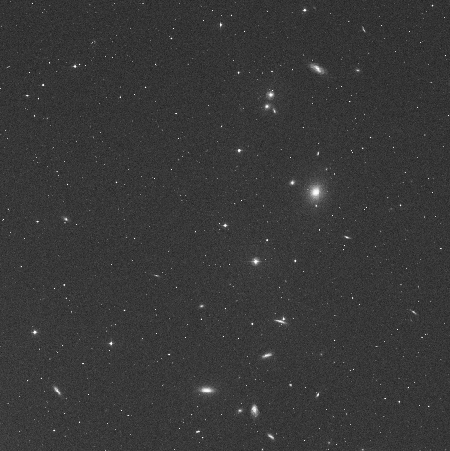
Seven of the brightest galaxies in this photo were observed in the one
field of view (1.3 degrees) on Wednesday in Virgo. The brightest galaxy
on the right is NGC4261.
The image is 60f
wide.
The
Digitized Sky Survey copyright © 1994
The maximum number of galaxies that I observed in the same field of
view during three days of the session was 7 (the photo above). I
believe this is the record high of my comet hunting activity.
It is fun to check DSO, but confirming hosts of them for three
consecutive days was somewhat tedious.
Thu Nov 27
Three weeks have passed since I comet hunted last, because winter type
pressure pattern cased nasty weather that kept me from observation.
Ironically, the sky was clear just before and after the full moon this
month when I do not comet search. Actually, this happens frequently!
This time, I believed the forecast and went to bed at 8p.m. at the
previous night. At that time the sky was crystal clear. I wake up
before midnight that meant the sky was still clear and actually so. My
body sensor seems to be sensitive to the fine weather, and in fact it
often wakes me up. But it was too early, and I went to bed again. At
2a.m. I roused naturally again. It was a bit early, however, I decided
to go comet hunting.
Some 20 minutes drive led me to my favorite observing site.
Surprisingly, at 2:40a.m., I heard the noise of machine from far away
that must be construction of the road. It was no surprise if you were
in urban area, but I was here in rural area. We have so much snow in
this region, and the construction firm wants to complete the work
before winter. My mind was not very calm due to the noise, while the
sky was superb! I could observe the counter glow.
Just after the start of the session, I noticed the star image was
somewhat blurred. Very thin cloud began to spread over the sky. This
situation got worse as time went, and finally over the 80% of the sky
was hidden by the cloud that lasted for around an hour. I was forced to
aim at my comet seeker at the gaps of the cloud; NE, SW, and low
altitude in the south.
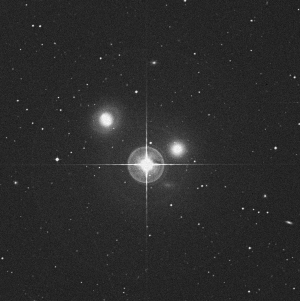
NGC3637 (left)
and 3636 (right) with 6.6 magnitude star in Crater.
The image is
15f wide.
The
Digitized Sky Survey copyright © 1994
Suddenly, at 4:40a.m., starry sky began to spread and the condition
became perfect. I enjoyed the hunting to the full after that, since I
identified many galaxies unexpectedly in the constellation of Crater.
The most impressive one was NGC3637 and 3636 that are located at 3f NE
and 1.7f NW of 6.6 magnitude star: GSC 5511:1183 (11h 20m 31.28s,
-10?17f40.5h). Both the galaxies are 12th magnitude. Other than those I
identified a dozen of them, most are 11 and 12th magnitude. I
remembered there are hosts of galaxies in the area in the result.
After I got home I wondered how far those galaxies are. It is easy to
investigate the distance since the recessional velocity of galaxies is
listed in some web pages: e.g. you can search it at the following page.
http://leda.univ-lyon1.fr/
You can estimate the distance dividing the retrieval velocity by the
Hubblefs constant (=71 (km/s)/Mpc). gMpch means Mega parsec that is
equivalent to 3.26 light-years. The farthest galaxy that I caught this
predawn was NGC3660. The recessional velocity is 5040 (km/s)/Mpc that
indicates the distance is 230 million light-years. Most of the galaxies
I observed were 70 to 80 million light-years. How interesting and how
easy! Nowadays, you can search and have a look at NGC catalog or the
other so many catalogs with the Internet.
http://www.seds.org/~spider/ngc/ngc.html
Sun Nov 2
I wake up before 3a.m. The sky was apparently darker than last dusk
since the light pollution was mitigated. Even so, light pollution
strongly affected the observation. The most light polluted direction
with respect to the intensity was the NE, my town, around 20 km away
only 70,000 of population, while the light pollution spread most widely
in the SE, the direction of Tokyo area: the observing site was 50 km
away from Maebashi and Takasaki area with population of 700,000, the
northern edge of the Metropolitan area. The center of Tokyo is 150 km
away from the site. Light pollution of Nagano and Joetsu, both are some
50 km away, were also eminent.
Before starting the hunting session, I observed C/2006 OF2 Broughton.
This comet was bright with a 2f ?long tail and easy to see. I also
tried to observe 17P Holmes but could not detect.
After that I challenged Barnardfs Loop with unaided eye using H-beta
filter. Actually, I observed this object some weeks ago in front of my
house. It was observable with direct vision and easy with averted
vision, and I also confirmed there was a nebula-like-object in the
south of Zeta Orionis. With 4x22 mm binocular both of them were much
clearer. I also saw a nebula in Auriga using H-beta filter that must be
IC405, though I did not confirmed the position with the atlas.
I began to comet hunting from M105, and was determined to identify so
many galaxies. Zodiacal light glowed as bright as light pollution of
Tokyo area. This gnatural light pollutionh reduced the limiting
magnitude by one or more. The comet seeker swept from Leo to Virgo and
Coma Berenices. I had been busy identifying the galaxies using the NGC
Max. At 5:00a.m. a quarter after the beginning of the twilight I saw 6
galaxies in one field. I remembered this group of galaxy. It is a part
of Markarianfs Chain that I mentioned in the Diary of 2006. As a result
I detected 47 galaxies during one and half hours of session. But this
is not record high: I have ever identified 70 galaxies in one session!

Part of Markarianfs
Chain that I observed in Nov 2006. Galaxy at the center is M86. This
image is 1 degree wide.
The Digitized Sky Survey copyright © 1994
Last dusk, I observed the counter glow and during the predawn session I
saw zodiacal light stretched up to 70 degrees before the start of the
twilight. Frost was formed on the light shroud, secondary cage, mirror
box, and my down jacket, but it did not bother me. It was satisfactory
night.
Sat Nov 1
It was raining before noon, but both the forecast and the satellite
image implied the recovery of the weather. I headed for the best
observing site. As my car approached the site, I noticed that some of
the mountain tops near the site were covered with the cloud. Even so, I
believed the clear sky at the observing point and continued to drive.
I arrived at the site just after the sunset. Soon after the arrival,
the crescent moon and Venus welcomed me, and the cloud began to
dissipate. Beautiful dusk!
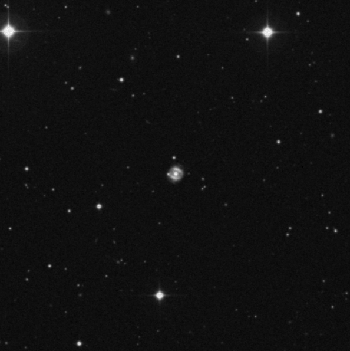
Tiny planetary nebula in Hercules, NGC6058. The image is 10' wide.
The
Digitized Sky
Survey copyright ©1994
I started comet searching from NW, mainly Bootes and Hercules, and
identified NGC6058, M94, and M13 with NGC6207. NGC6058 is a tiny
planetary nebula, and in many cases you tend to overlook such a small
one since you cannot distinguish it from a star. This time I could
since the nebula was at high altitude, however, I missed NGC6210,
brighter planetary nebula in the same constellation, Hercules: it was
only 15 degrees above horizon. After completed the session I confirmed
how NGC6210 looked: the stars in the field were swelled due to
scintillation that had the same size with the nebula. For several
seconds of observation I could tell NGC6210 from the stars because the
latter twinkled (exactly, the shape varied with time) while the former
did not.
Interrupting the session for a few minutes, I observed C/2008 A1
McNaught
that had a 2f-long tail and was bright. After the session, I looked at
6P dfArrest, 205P Giacobini, and C/2006 W3 Christensen. 6P looked very
faint because of light pollution of Tokyo Metropolitan Area. Lumicon
Comet filter was very effective for this comet than the light pollution
filters.
As time went, the sky became darker and superb! I must say the sky was
as excellent as that in Hawaii in my impression. I tried to observe
California Nebula using H-Beta filter with naked eye. It was easy! I
could observe the nebula with my single eye using the filter, and could
recognize that it has elongated shape with averted vision!
With averted vision I identified M33 that I used to look at it with
direct vision in my boyhood. Maybe, my eyes deteriorate due to aging.
To measure the naked eyes limiting magnitude I observed stars with
averted vision near the foot of Pegasus without prior knowledge, and
then confirmed the existence of them with a binocular. I identified the
two stars in my house:
T 2229:1549:1
PPM 114881
SAO 90833
HD 216285
RA: 22h 51m 26.670s
Dec: +26º23' 27.80"
Mag(v): 6.95
B-V: +0.249
T 2246:1707:1
PPM 114924
SAO 90859
HD 216586
RA: 22h 53m 48.770s
Dec: +28º37' 33.50"
Mag(v): 7.38
B-V: +1.155
Could I see a 7.4 magnitude star at the site where the altitude is
800m? Even in Hawaii (2800m) naked eyes limiting magnitude was 7.5 to
8.0. But this must be true. Body condition must be worse during the
travel than usual.
I had an urge to stay up longer to enjoy splendid sky, but I went to
bed at 10p.m. in my car for the predawn session.
(Diary at Sunday predawn will be posted in a few days)
Oct 20 Mon
I began to comet search at 3:10a.m. from gamma Leo under the bright
moon light. Many dark galaxies are around this region, but I could not
detect any of them because of moon light.
Orionids was its peak this morning. However, I did not observe meteor
at all both by naked eyes and via comet seeker. I observed a host of
Orionids last year.
This predawn it was monotonous comet hunting session, but you should be
cautious all the time. As someone said, gThe big one may be waiting for
your discovery out thereh.
Oct 18 Sat
The sky has been clear since Monday. I enjoyed observing Jupiter on
Wednesday and Thursday, as seeing was excellent for my city (rating
7/10) and the moon was full on Wednesday, i.e. I do not comet hunt.
<Jupiter>
On Wednesday from 6:00p.m. to 7:30p.m. I observed Jupiter with my 30 cm
telescope, Hawaii telescope. I observed with single eye and after that
I used a binoviewer. Apparently the latter offered better view of the
planet. I could observe a structure in the Great Red Spot, i.e. vortex,
for the first time!
At Thursday dusk I employed my 46 cm comet seeker in addition to the
Hawaii telescope. Evidently, the performance of the 46 cm was superior
to the Hawaii under such good seeing. Sometimes I recognized many white
spots and details of the belts. I aimed the 46 cm at Altair and tried
to check the diffraction ring, and I saw it for the first time with the
scope.
On both the days, at 9:00p.m. seeing turned to worse that I could
recognized with naked eyes; the stars were twinkling with high
frequency.
Scintillation was bad as usual on Friday and Saturday. Seeing in my
area is very changeable and we seldom encounter excellent one. However,
it is not a serious problem for visual comet hunting.
<Comet hunting>
Apart from Jupiter, I conducted comet hunting on Saturday that was the
7th session this month. Before the session, I observed C/2008 A1
McNaught for the first time at 6:10p.m. It looked very faint and was
the limit of the 46 cm because of twilight, light pollution and low
altitude (15 degrees). I made a memo on the appearance of the comet,
and I peered into the eyepiece again at 6:13p.m. Surprisingly, the
comet was much brighter, and I felt I would never overlook the image
during the searching session! Brighter than 9th magnitude.
I did not know the reason for rapid change in appearance. The comet
might be covered by thin cloud. I tried to observe the comet at
6:55p.m. again, but could not see it due to lower altitude (6 degrees).
Finally, by applying the light pollution filter I recognized the comet.
I do not like to use the filter, since it swells the star image that is
uncomfortable. Even so, I sometimes apply the filter depending on the
condition.
This time I overlooked M107 that was in the area where I swept, because
the overlapping of the telescope field was not enough. The observation
of C/2008 A1 McNaught and the overlook of M107 was a lesson: it is not
easy to spot a new comet if it would be within your search area.
Thu Oct 2 to Fir Oct 3
Excellent transparency! The forecast said it would be clear throughout
the night, and I decided to go comet hunting to the best observing
site, one hour drive from my home.
At the time of the twilight end, I was disappointed to see the light
polluted bright sky. The impression in Hawaii was still in my mind, and
the gap between Hawaii and usual site was so big. Anyway, I started
comet searching and spent one hour and a quarter. During the session I
tried to observe 6P dfArrest that looked bright in Mauna Kea, but could
not look at the comet since it was hidden by the woods.
The sky got dark as time went, and I tried to confirm the impression in
Mauna Kea in comparison with the usual site. For instance, I confirmed
that the detail of the Veil nebula looked better with 46 cm here than
with 30 cm in Hawaii, but the image seemed crystal clear and distinct
in Hawaii that gave me strong impression in Hawaii.
After four and half hours sleep in my car, I conducted predawn comet
hunting session. The major search area was Leo. I identified 16
galaxies. Seven out of 16 were detected during the twilight; NGC3607
(9.9), 3608 (10.8), 3626 (11.0), 3344 (9.9), 2968 (11.3), 2964 (11.7),
and 3245 (10.8). The parenthesis is the magnitude displayed by the NGC
Max. The last one, NGC3245 was identified some 20 min after the start
of the twilight.
Transparency was excellent but seeing was extremely bad. I guessed this
terrible seeing degraded the image of the deep sky objects. However,
with the help of outstanding transparency, zodiacal light was bright
and that crossed the winter Milky Way. The former was somewhat
obstructive for the hunting session, but I felt the depth of the
universe from the scenery that I enjoy every year in this season.
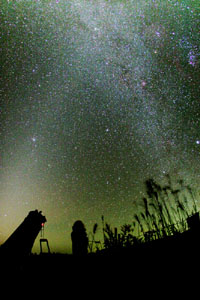
Click to enlarge.
Depth of the universe: a cross of the solar system and our galaxy.
Tue Sep 30
Last week I went to Hawaii for star gazing with my friend, and utterly
satisfied with the dark sky!
It is the place where the Earth and the Cosmos contact. For the detail
please click here.
Tue Sep 9 to Thu Sep 11
It has been nation wide clear sky for three consecutive nights, and I
conducted satisfactory comet hunting sessions for three predawn. It was
not only me who did, of course: Koichi Itagaki and Hiroshi Kaneda
spotted a possible new comet on Sep 10 UT that turned out to be D/1896
R2 (Giacbini). It is great work to re-discover this lost comet that was
observed last in 1897! Their discovery also encourages comet hunters to
show it is still possible to find a new comet.
For me the most interesting session of the three nights was that of
September 11th. I started from M78 in Orion at 2:45 a.m. and spotted a
comet like object at 3:25 a.m. I could not identify it using the NGC
Max digital setting circles! I opened the Uranometria 2000.0, and I
found a large diffused nebula was there. However, I still doubted
if
the object might be a new comet since the nebula in the Uranometria has
several degrees in length. The object was north of the 10th magnitude
star, GSC 709:857, 05h31m27.98s, +12deg 09f 10.5h, with a diameter of
1f to 2f. I made a quick sketch and confirmed the motion at 4:00 a.m.:
no motion. What a relief with a little disappointment!
After one month of patience, i.e. cloudy and rainy nights, I really
enjoyed the hunting sessions.
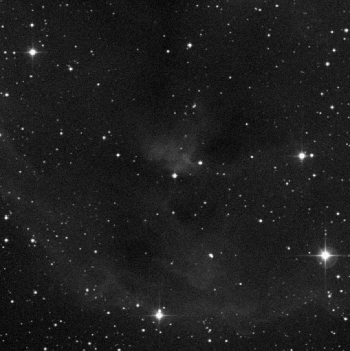
A new comet? The star at the center with a nebular ti the north (up) is
GSC 709:857, 05h31m27.98s, +12deg 09f 10.5h. The width of the image is
15'.
The Digitized Sky
Survey copyright ©1994
Another story: My compact 30 cm reflector has completed. It features
carrying with a suitcase. I had the first light on September 7th,
though cloud cover was 90% of the sky. I aimed Vega first, and the next
was Jupiter. I could observe both less than 30 seconds due to cloud but
seeing was excellent for this area. Jupiter was jaw dropping! I will
report on this telescope someday.
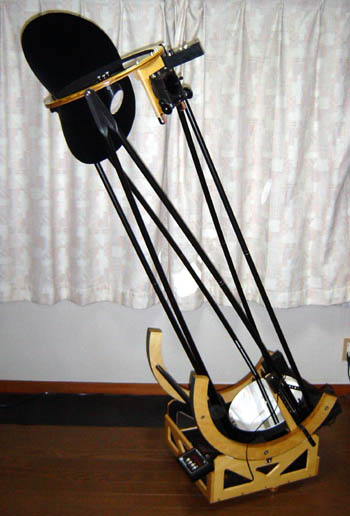
A new 30 cm reflector
Sun Aug 31
Incredibly, bad weather lasts throughout this month, and I comet hunted
twice this month as I wrote in the previous dairy.
An article on September issue of the Sky and Telescope magazine
entitled gThe Coming Giant Sky Patrolsh reads gDeath of Amateur
Astronomy c or New Birth?h
Todayfs sky surveys inflict extensive damage for amateur astronomers,
but future surveys will much more.
The first stage of the Pan-STARRS, powerful sky survey project with the
limiting magnitude of 22.7, starts the operation at the end of this
year atop Haleakala in Hawaii. At present a prototype 1.8 m telescope
is about to work, but the final system comprises of the same four
telescopes that will start in 2011. Combined aperture is 3.6 m that
will discover much more asteroids and comets than any other existing
surveys.
The article does not state that the Pan-STARRS is a finish blow but
Large Synoptic Survey Telescope, LSST is. The primary mirror is 8.4 m
larger than the Subaru telescope at Mauna Kea, Hawaii. As you know you
cannot measure the effectiveness of the survey only by the aperture.
The larger the aperture is, the narrower the field becomes, generally
speaking. This rule does not hold true for LSST. It has 8.4 m F1.18
optical system with the field of view of 3.5 degrees using the world
largest camera: 32,000 mega pixel CCD! On top of that the aberration at
the edge of the image is less than 0.2h.
LSST will cover the entire sky in three nights, and estimated alert
would be 10,000 per night that will be released real time. Amateurs can
observe new objects or phenomena referring to the alerts, but I am not
fascinated by it. The article concluded that gYes, traditional amateur
doors to discovery are closing. But more are opening uph. Probably it
is true, but it is still possible to discover a new comet. This might
be the last chance.
Pan-STARRS
http://pan-starrs.ifa.hawaii.edu/public/
LSST
http://www.lsst.org/lsst_home.shtml
Sun Aug 10
Last dusk I worked as a volunteer guide of star watching. Around
thirty people enjoyed observing Moon and Jupiter with telescopes, and
the constellations with naked eyes. Most attendees, including some
local people, came from all over the nation to attend the activity of JEN, NGO; they take
action to support a depopulated farm village near my city that was
damaged by an earthquake in 2005.
It was a hard work for me to operate three telescopes at once as I was
an only guide for many audiences, but I was rewarded all the people
said gWow!h too see the moon, Albireo and Jupiter. I came home at 10:20
p.m. and went bed soon for the next predawn session.
I wake up at 1:50 a.m. but it was cloudy. I guessed it might be a
temporary situation, and watched the sky at 2:30 a.m. again. Clear! The
transparency was apparently inferior to last night due to haze.
I stated the session at 3:00 a.m., but few stars were observable
through my 46 cm comet seeker at the altitude lower than 20 degrees.
The only deep sky object that I identified was M77 in Cetus. If the
transparency had been high enough, I could have spotted many galaxies
in the area.
Sat Aug 9
This is the first comet hunting session this month. Like last month
it has been cloudy especially only at night, even if it was fine in
daytime.
Before the start of the session, I tried to observe C/2008J1 Boattini
but cloud not see partly due to light pollution. I observed the comet
last month with 11th magnitude that looked the limitations to spot
during the hunting session. The next target, C/2007 W1 Boattini, was an
easy object, but looked fade in comparison with last monthfs
observation.

M38 (the upper cluster) and NGC1907.
The Digitized Sky
Survey copyright ©1994
At 2:20 a.m. I began to sweep from C/2007 W1 toward the east. I knew
there are few comets like objects except M1 in this region. I was
impressed by the two major open clusters M45 and Hyades (Melotte 25)
passing through the field! Some 30 minutes later a comet like object at
a low altitude startled me, but after a second I recognized it as M1.
In the constellation of Auriga I encountered the three sparkling open
clusters M36, M37, and M38; they looked like old friends whom I had not
met for a long time since I have not observed them for several month.
NGC1907, a neighbor of M38, is a tiny open cluster that is more
impressive than M38 with my 46 cm; M38 is too sparse at 68x.
15P Finlay was within the search area of this session but I did not
spot it probably because of the haze at a low altitude and the twilight.
Mon Jul 21
It has been cloudy and I comet hunted only once this month. There were
some clear days but I was clouded out at dusk and/or predawn. Even if
the sky was gclearh, in some cases transparency was too bad to comet
hunt. It seems like that the number of such unsuitable days for comet
hunting increased recently.
I have read about transparency in the August issue of the Sky and
Telescope magazine. Major cause of haze is aerosol cased by both human
activities and natural processes. The former is sulfur oxide (SOx) or
nitrogen oxide (NOx) originated from fuel power plant and vehicles that
causes photochemical smog leading to spread ill health. The latter is
volcanic or forest fire smoke, but in Japan pollen from planted forest
sand and yellow sand from Chinese desert should be added. Aerosol also
boosts light pollution.
As far as I know, we have never experienced urban ozone here in the
Japan Sea Side, since there are no big cities around the area; however,
it occurred last year for the first time. Due to spiraling economic
growth in China these harmful gases flew from the continent. You cannot
say that we, Japanese, are just injured party but at the same time
victimizer. Japan import huge amount of products from China and the
gases are released under the production processes.
To enjoy clear and dark sky we have to be greenc but what we should do
for that?
Anyway, the Japan Meteorology Agency stated that the rainy season
seemed to finish on this weekend. Now, we are at midsummer to enjoy
stargazing.
Wed Jul 2
Precious clear sky!
It was slightly fogy, and I knew I could avoid it if I had driven
twenty minutes to a hill. Unfortunately, I could not afford to do so,
because only ten days has passed since the summer solstice and the
twilight begins at 2:30 a.m.; I have to get up very early at 0:30 a.m.
to go to the hill.
I got up at 1:00 a.m. and completed setting up my comet seeker in front
of my house at 1:30 a.m. I had to fix two stars to set in the NGC Sky
Vector. The first star was Fomalhaut, Alpha Piscis Austrini, and the
second was Alpheratz, Alpha Andromedae. When the telescope was aimed at
Alpheratz I noticed a comet like image near the star! At the next
moment I realized that the star was not Alpheratz but Beta Andromedae,
as the NGC Sky Vector indicated the warning for the wrong alignment.
Anyway, I spotted a possible comet!
My heart began to beat faster and faster. I changed eyepiece from
Planocular 30 mm (made in German with apparent field of view of 88
degrees) to Ethos 13 mm, but apparently the image was comet like! I
opened the Sky Altus 2000c I found NGC404 is just near Beta Andromedae.
I must have observed this object last year or so, nevertheless, I took
it for a possible comet.
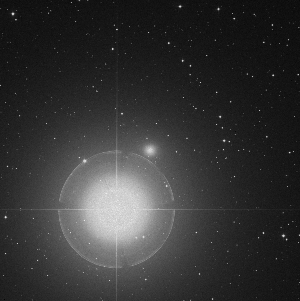
NGC404 (center) and Beta Andromedae
The Digitized Sky
Survey copyright ©1994
Before the start of the comet hunting session, I tried to observe
C/2008 J1 Boattini but I could not see the comet at a glance. It must
be defused, but I did not check carefully to identify it since I felt
that it was waste of time; I am not a comet observer but a comet
hunter. At least I can say that I could not spot C/2008 J1 if it would
have been a new comet.
I observed several meteors through my comet seeker and one by naked
eyes during the session in addition to NGC488, 524, and M74 that looked
huge in apparent diameter. After the beginning of the twilight I
observed 15P Finlay. The comet was some 15 degrees above the horizon
but I could observe it. Since the image was very faint it was
impossible to discover this comet during the comet hunting session. I
enjoyed stimulating session.
Mon Jun 23
So far I have comet hunted three nights this month. The other day
the Japan Meteorology Agency declared the rainy season started in my
prefecture, and I cannot expect clear sky for about one month from now
on.
Under such nasty weather, I want to go star watching to splendid place,
e.g. Hawaii, with a large aperture telescope. I have such a feeling
every now and again, especially in winter and the rainy season.
Actually, I began to make a 30 cm Dobsonian by wood that can be carried
in a suit case and can be handled as a check-in baggage for air travel.
I will travel all over the globe with the scope!
However, I was upset to read an article of Mitsunori Tsumura in
an astronomical magazine. When he arrived at an air port in Australia,
he had to declare all the wood products that he had at the quarantine.
His Dobsonianfs rocker box was manufactured by wood, and the officer
stated the inspection was required, because there were some wormholes
on it. The officer said it would take at least three days, and Tsumura
abandoned the rocker box. He bought wood and a saw at DIY shop to build
a new rocker box on site.
I inquired Australian embassy in Tokyo if I can take fumigated wood
products with certification. The answer was that the final decision
would be made by the officer. If you visit Australia you should bring a
telescope that does not involve wood material!
Anyway, at least I can fly to Hawaii with the new 30 cm scope, probably
this year.
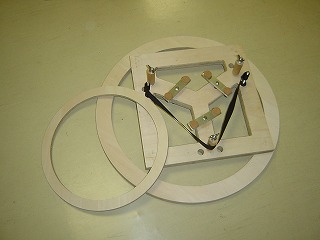
Top ring (small ring), side bearing (large ring, yet divided), and
six-point support mirror cell.
This telescope is based on Alan Scottfs 30
cm Dobsonian, and gThe
Dobsonian Telescopeh.
http://www.willbell.com/tm/dobtel.htm
Mon Jun 9
It has been nasty weather last month, and I comet hunted only three
nights; none of them were preferable conditions due to gauzy clouds.
Such clouds not only reduce transparency but also enhance light
pollution.
I arranged my Borg 125ED refractor with Vixen Porta altazimuth
that is equipped with the digital setting circles (refer to the diary
on January 18) so that I carry them with ease. I manufactured a wood
box that can carry the optical tube assembly, the dew shield, the light
shield for an eyepiece, and the computer of digital setting circles.
The altazimuth mount is protected by polyurethane board that is taped
with thin stainless steel adhesive tape. A small camera bag, lower
right in the photo, is for small parts; eyepieces, a 2 inch erect
prism, and the Quick finder.
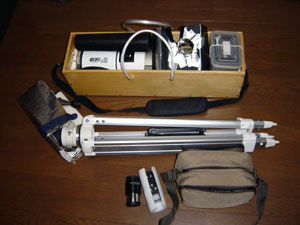
Home made wood box, polyurethane protector for the altazimuth, and soft
bag for small parts.
I conducted comet hunting at dusk for ten minutes last month using this
system. It was handy and easy to operate, while what I do not like is
intolerant of wind, and long damping time of vibration especially for
high magnification. For these reasons, this system is not suitable for
lunar and planetary observation.
After using the 125ED refractor I continued comet searching with my 46
cm comet seeker.
I tried to compare the differences in power between the 46 cm and the
125ED. I identified NGC3377, a galaxy in Leo, with the 46 cm, it was
bright and very easy object. Then I aimed at the same galaxy using the
125ED. It was faint and could be barely recognized with this small
aperture. The 125ED looked like a finder of the 46 cm in terms of the
light gathering power, but the field of view is over six times larger.
I may not the 125ED so often in the future, but fiddling with the scope
is enjoyable at cloudy nights.

125ED system in front of the certain; if only I open the certain I can
start comet hunting from the room that directed to the southeast. I may
not able to set digital setting circles since it is often difficult to
fix two stars from the window. Even so, I can measure both vertical and
horizontal angular distances between a known star and possible comet
using the digital setting circles, if I spot an unknown object.
Sat May 16 to Sun May 17
I attended the 38th Comet Conference in Hiroshima that featured a
special guest Mr. Robert McNaught from the Siding Spring Observatory,
Australia. I enjoyed the Conference this time; I hosted the Conference
last year, and I had been assigned a chairman of the comet hunting
session of the Conference many times but not this time.
As a professional scientist I had wondered if McNaught was not obliged
to write scientific papers, even though he is a professional
astronomer. Actually, he wrote some scientific papers but it does not
seem to be his main work. If he is hired as an engineer, he cannot
employ the Schmidt camera exclusively for long time. If only I had read
the web page of
the Siding Spring Observatory, I would have obtained the answer
soon, but I did not.
I understood why he can concentrate on the searching activity to listen
to his speech: he was hired to search new objects. How affluent the
Westerners are! In our country it never happens. Japan is poor in that
way. I believe creativity
is formed where there is enough scope, which in many cases produces
something impressive like a work of art. His job, though it is a part
of the Survey Project and done through the electronic displays, is
similar to that of an artist, because his discovery is made with hnaked
eyesh via the displays applying his strong will to do so. We, amateur
comet hunters, want to be the same. The audience was impressed with his
speech, because he has such an enthusiasm.
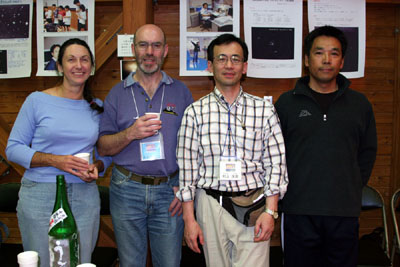
From left to right: Ms.and Mr. McNaught, Murakami, and Ichimura
(Discoverer of C/1987 W1 Ichimura)
Note that a bottle of Japanese alcohol "Sake" on the left.
Someone put a question, and he answered.
Q: What is the driving force to continue to search new objects?
A: It's fun!
To hear his answer, we felt his pure nature that endorsed by an amateur
spirit, and that drew applause from all the audience!
Yuji Hashimoto in Hiroshima, the Vice Chairman of the Conference, is a
visual comet hunter, and he goes comet hunting to suburban area driving
a camping car. He said he purchased his camping car for comet hunting.
On weekdays, he gets home, eats supper, takes a bath, leaves his house
with his camping car in the evening, has a good sleep in the car, and
then comet hunts at predawn. He goes to his office from the observing
site directly after the daybreak. Enthusiastic!
For me genthusiasmh seems to be a keyword for this Conference, and I
was stimulated in that way.
Nothing great was ever achieved without enthusiasm.
Ralph Waldo
Emerson
U.S.
philosopher, poet and essayist, 1803-82
Tue May 6 to Wed May 7
I headed for one of the best observing sites with an altitude of
800 m a.s.l. but I wondered if the road was open: snow might remain in
some part of the road. Luckily, I could arrived at the site, however,
judging from the existing snow amount near the site I felt I could not
have reached the place, if I had tried to visit here a few days earlier.
Before I started to comet hunting, I observed C/2007 W1 Boattini. It
was bright and large! Then, I began to comet search from the north of
Alpha Gemini, Castor. The reason was simple; light pollution is less in
this direction. The first comet like object I identified was NGC2372, a
planetary nebula, in Gemini, but I failed to detect brighter planetary
nebula NGC2392, Eskimo nebula. This is because the nebula was tiny and
very bright, and looked like a star. The other comet like objects I
caught were galaxies NGC2672, 2749 (both are 12th magnitude), and 2903.
After the hunting session, I made a sketch of C/2007 W1,
and enjoyed deep sky objects, M51, M101, and M13. The spiral structures
in M51 and M101 that are well recognized with averted vision at the
observing site near my house were apparent with direct vision, while
M13 did not resolved well because of poor seeing.
Unexpected light pollution spoiled the southern sky this evening, and
it turned off at around 10 p.m. I guesses it originated from the ski
fields that were still open. On Wednesday my colleague told me that it
was true. After that, I had a good sleep in my car for three hours and
half.
Wed May 7
I wake up at 2 a.m. and noticed that the transparency got worse
than yesterday. Some
200 m apart from my site, I saw a light last evening and it was still
on. I though it must be astronomer's one and aimed at my comet seeker
before the comet hunting session.
The answer was yes! A man operated a reflector about 25 cm in aperture.
I
searched the northeast for one hour and a quarter, but the only nebula
that I identified was Andromeda Galaxy. Exactly, I observed not only
M31 but M32 and M110. I wondered if there might be some galaxies that I
could catch in this region, but under this sky condition these could be
overlooked.
After the daybreak I visited the man for greeting. He looked in his
sixties and said came from Saitama Prefecture, Tokyo area. It takes 3
hours from his house here. He also said that he tried to come here on
April 30 but
could not because of snow.
Tue Apr 29
Though the forecast predicted clear weather yesterday, it had been
cloudy with poor transparency in daytime. I did not expect clear sky at
the next predawn, and stayed up late last night. At 10:00 p.m. I
checked the sky and noticed that stars were twinkling with good
transparency; the different characteristics of air mass had come into
my region. I went to bed right away, and set an alarm clock at 1:30 a.m.
I woke up as scheduled, but the sky condition was much poor than I
expected. In no time I noticed that it was time for Moon rise. It was
already on the horizon but the woods hid it. It took longer than usual
to set up the comet seeker due to only 3 hours sleep, i.e. my body did
not work well. OK, no need to worry about it because it is national
holiday today. I wonder if from where I should start the hunting
session: the east or the west of the moon. I decided to begin with the
west of the moon, the constellation of Sagittarius, since the moon was
there in the previous day and the moon light around the position made
it difficult to detect a new comet.
Some deep sky objects (DSO) brighter than 9th magnitude went across the
field. If it had not been for the moon light, I could observe 11th
magnitude DSO in this region. A globular cluster M22 that resolved up
to the center, was impressive with several bright stars; five to 7th
magnitude and SW of the cluster in the same field of view. At the next
swing of the telescope this cluster crossed the field again, but it
looked only dim object due to the moon light without bright stars in
the field. As the telescope approached to Moon, the contrast in the
field got worse and I decided to shift to the east of the moon
when Jupiter came into the field.
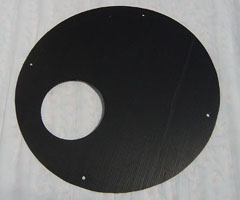
The mask for the
moon and the planets observation.
The aperture is 18 cm.
I aimed the comet
seeker at M15 and resumed comet seeking when the twilight started, and
finished today's session in 30 minutes.
Before taking down the comet seeker, I enjoyed Moon watching using the
BinoVue. I manufactured the mask for the moon and the planets
observation some years ago that apparently improved the image in most
cases in my observing site in spite of reducing the aperture down to 18
cm.
Wed Apr 9
Awesome! This is the most fruitful comet hunting session among the
three this month, though there was not a speck
of cloud in the sky in all these three predawn sessions. Today it was
dry and clear for spring (usually hazy) with little wind. I
started with M4, a globular cluster in the constellation of Scorpius,
1.3 degrees west of Antares. The stars in the cluster resolved easily
and impressive with 46 cm 68x. The next swing of the scope from an
altitude of some 40 degrees to the horizon led me to
another globular cluster NGC6144, 0.6 degrees northwest of Antares.
This globular cluster also resolved into stars, and the contrast of the
cluster and dazzling Antares was vivid.
I had prepared for identifying a host of globular clusters, and as
expected I did nearly 40 of them during one hour and fifty minutes of
the
session. As for open clusters I cannot tell how many of them I caught;
for one thing any part of the Milky Way looked like an open cluster due
to high
light collecting power of my comet seeker, and for another I do
not
identify most open clusters that resolve into stars.
M7, NGC6453, and NGC6444 were in the same field of view with 68x, but
each of them has completely different appearance. M7 is the sparsest
and occupies large area of the field with many bright stars; NGC6444 is
moderately condensed and
middle sized; NGC6453 is the darkest, smallest, and highly condensed because this is a
globular cluster.
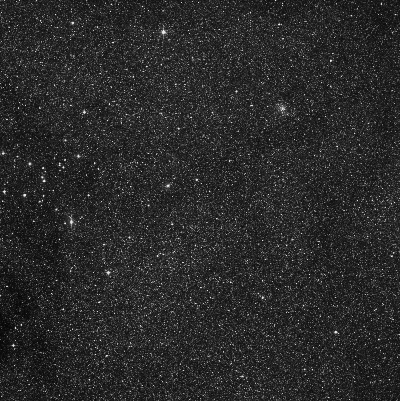
M7 (left), NGC6453
(upper right), and NGC6444 (right)
NGC6444 is not distinct in this photo since limiting magnitude of the
image is too dark and so many stars are shown. Image is one degree
wide.
The Digitized Sky
Survey copyright ©1994
Besides star clusters, I have met other sorts of deep sky objects except galaxies: planetary nebulae,
reflection nebulae, and dark nebulae. My space walk has completed at
M54 at 4:30 a.m. before my comet seeker reached Jupiter.
Sat Mar 22
To date I have conducted the comet hunting sessions three
times
this month, although I got up in the wee hours six times in total;
i.e. I could not comet search three predawns in spite of going out of
bed. Two overcast and
one extremely bad transparency due to yellow sand from the continent
dessert prevented me from the hunting.
As I have not yet observed C/2008 C1 Chen-Gao, I tried to observe the
comet
tonight regardless of the full moon. At a glance I did not notice the
comet at 68x with my 46 cm comet seeker. I
peered into the field comparing with the star chart that I printed out,
and finally spotted the possible image. I boosted the magnification up
to 157 changing the ocular to Ethos 13 mm, and I firmly confirmed the image was the
comet. I estimated the comet as the
magnitude of 11.0. Under the
moonlight like this I had not spotted this comet if I would have made a
comet hunting session. In case of a dark night, however, I would never
fail to
overlook
this image.
I also tried to observe 17P Holmes and 46P Wirtanen, but I could not
confirmed both the comets because of the moonlight even with 46 cm.
After observing comets I enjoyed Moon and Saturn using the BinoVue
(Televue's binoviewer). Most
Newtonian telescopes does not achieve focus with binoviewers, and I
combine Bino Vue with the
Optical Corrector Assembly (OCA) supplied by the Siebelt Optics. The
manufacturer carries various sorts of binoviewers and the attachments.
I
purchased the "Universal OCA" several years ago. With this model three
magnifications of OCA, 1x, 1.5x, and 2x, are available by replacing
and/or adding the lens elements, and you can utilize it for both
Newtonian
reflector and the refractor, though my 46 cm does not focus for
1x.

From left to right: one of the SWA 20 mm 70 degrees eyepiece, BinoVue
with another SWA 20 mm, a pair of Pentax XW 10 mm, OCA and two
corrector lenses, and a 2" barrel with the filter to attach the 2"
filter to OCA.
For planet and moon observation looking at both eyes (applying the
binoviewer, not using a binocular telescope) reveals much more details
than a
single eye in my experience.
I usually enjoy observing the planets or the moon after completing the
comet hunting session before the daybreak that means more than 30
minutes from the start
of the twilight. Though scintillation in my city is notorious
throughout
the year,
before sunrise the scintillation seems to be rather
stable: even so I have seldom recognized diffraction ring at
any apertures of telescopes in my city! This implies poor scintillation
does not affects comet hunting seriously, probably
because
we apply low magnification. If star images
are swelled even at a low power you will be disappointed to look into
the eyepiece: I have experienced such a situation at dusk but it
recoverd in no time with a drop in temperature.
Sun Mar 9
Spring has come! The forecast predicts we will have a couple of
fine days this week that never happened in January and February in my
area, Japan Sea side. I comet hunted only twice last month, February 5
and 11, and this predawn is the first comet hunting session this month.
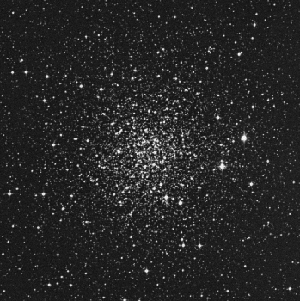
NGC6366, Image is
15' wide
Alike
NGC5897 on the Diary on February 5, this globular cluster
is defused, and tend to overlook under light polluted condition. It
looked granular using my 46 cm comet seeker, but did not resolve
into stars shown in this photo.
The Digitized Sky Survey copyright ©1994
As planed last night I got up at 2:20 a.m. and headed for the usual
observing site where I arrived at 2:55 a.m. At 2:20 a.m. I began to
search from M12 positioned at the center of Ophiuchus. I identified
some two dozens of deep sky objects, though the transparency of the sky
was not good that often occurs in
spring in Japan due to yellow sand
from China and pollen. Temperature
dropped down to minus 5 degrees in Celsius with a light breeze, but I
did not feel chilly now that it is the end of winter, and we are well
acclimated to coldness. The deep sky objects I detected included major
Messier Objects, M22, M 17, M8 etc., but the most impressive one was
NGC6366, a globular cluster in Ohiuchus. The diameter was nearly 10'
with low surface brightness, and the total magnitude was difficult to
estimate like that of Comet Holmes: about 10th magnitude
but 12th by intuition. Neither the Tago and Seki Catalog contain this
globular cluster, which implies that it is darker than 11 or 12th
magnitude the comet hunters' standard. The Sky Vector displayed it as a
10.0 magnitude object, and the MegaStar says it is 9.5 in magnitude.
Tue Feb 5
It has been snowy or cloudy this year. I got up predawn at least three
times last month, but in vain. Fortunately, last dusk I observed
17P/Holmes near Algol, beta Persei, for the first time this year
(it was second time!) with
8x50 binocular: that has a diameter of around 1.5 degrees and was
elongated. This fine weather trend lasted through the night, and this
predawn I could comet hunt for the first time this year with another
bonus: I tested unique product, Ethos 13 mm eyepiece.
At 2:30 a.m. I headed for usual observing site, but on my way to the
site I noticed a huge cloud appeared in the direction of the site. I
decided to get back and set up 46 cm comet seeker near my house. Before
the comet hunting session, I aimed the scope at M5, globular cluster,
in Ophiuchus. I compared the star image using Ethos 13 mm and Nagler
type 4 12 mm. When I first looked into Ethos I felt as if the super
wide angle of Ethos brought me into the space. The sharpness of the
star image and the contrast around the center of the field looked
similar in both oculars, but near the edge Ethos was superior to Nagler
in terms of homogeneity. Ethos has opened the new paradigm for visual
observation without doubt.
After impressive first light of Ethos I started comet searching,
however, cloud began to cover the sky. Ouch! I was overcastted at 3:30
a.m. At 3:45 cloud opened slightly at a low altitude in SE, but I could
sweep the area only for 5 minutes: it closed in no time. After a while
cloud got thinner and I enjoyed observing Saturn though thin cloud. I
repeated such actions but I was not frustrated. I continued hunting on
and off aiming the scope here and there, and identified faint galaxies
NGC5796 and 5898, and a globular cluster 5897 in Libra that are
difficult objects to catch at my usual observing site due to light
pollution from the ski fields: the overall sky condition there is much
better than near my house but SE is inferior in winter. My comet seeker
could resolve dozens of stars in NGC5897! At around 5:40 a.m.
about one hour before the sunrise, I caught M8, M28, and M22 at an
altitude as low as some 10 degrees. M28 looked like a comet and it
might be challenging to identify it without digital setting circles
under the twilight and at low altitude. I was satisfied with the
session after a long absence.
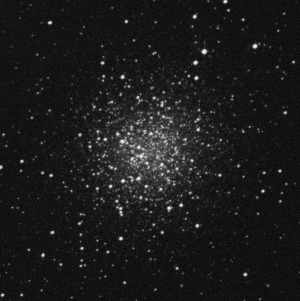
NGC5897 Image size is 15'x15'
This globular cluster looks defused image and it is difficult to
observe under light polluted sky: Seki catalog estimates it 10th
magnitude and 7f in diameter while Tago catalog dose 9th and 7f.
The Digitized Sky Survey copyright ©1994
Fri Jan 18
On Tuesday I got up four times at predawn believing the forecast that
said clear sky prevailed before the daybreak.
The first time, before 2 a.m. it was too early to do comet hunting.
Though I set an alarm clock at 3:30 a.m. since the twilight begins at
half past five, but I automatically wake up. Overcast!
The second time, at 3 a.m. Spica, Alpha Virginis, and a quadrangle of
Corvus were twinkling among a gap of clouds. The gap occupied only
small portion of the entire sky, but I expected it would extend in half
an hour.
The third time, at 3:30 a.m. the gap had shrunk, unexpectedly, but I
still anticipated clear sky in another half hour. Ten minutes past
four, the fourth time, unfortunately, dark snow cloud covered whole the
sky, especially the east. I checked a radar image using my mobile phone
that displayed some snow clouds around my town. Finally, I decided not
to comet hunt that predawn.
It was clear after sunrise and it lasted during the day time. There is
a time lag between the forecast and the actual weather for a few hours.
OK, it is cloudy or snowy tonight also. I have never comet hunted this
month. Even so, I have a lot of things to do. I bought a kit of digital
setting circles for the PORTA altazimth mount produced by Vixen.
The kit was supplied by Kokusai Kohki, Kyoto, Japan. This week I began
to install the kit: chances are you can discover a bright new comet
with a small instrument as Araki (Diary Dec 1, 2007) did in his discovery
of IRAS-Araki-Alcok (C/1983 H1), or like an outburst of 17P Holmes.
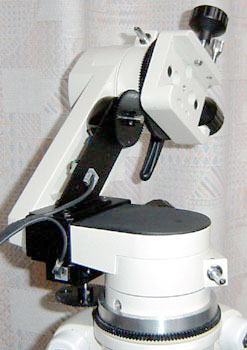

PORTA with digital setting
circles
14 cm Schmidt Newton
with Ethos 13 mm (apparent field of view (AFOV) is 100 degrees)
Early this month I brought a Schmidt
Newton (SN), 14cm f 500 mm, which was stored in my parentsf house. I
purchased it probably in the late 1980fs, but I seldom used it. I had
an idea to employ this scope with Ethos 13 mm eyepiece that I bought
this month also. This combination produces a magnification of 38x with
a field of view of 2.6 degrees! With PORTA it is compact and easy to
handle as a comet seeker.
Another owned scope for PORTA is BORG 125 ED, 12.5 cm f 800 mm. This
scope has been used with TA
altazimth, but PORTA is superior with respect to portability. With
newly bought EWV32 mm eyepiece (Kasai Trading, AFOV 85 degrees) and a 2
inch erect prism this scope has a magnification of 25x and FOV 3.5
degrees. This is also an attractive specification.
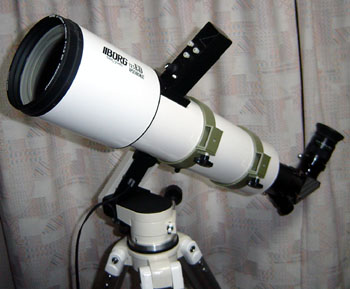
BORG 125 ED mounted
on PORTA
At first, I thought 14 cm SN has higher light gathering power than that
of 12.5 cm, however, it is not. 14 cm SN has rather large secondary
mirror of some 5 cm, and the corrector plate seems non-coated. The
secondary mirror reduces virtual aperture down to 13 cm and non-coated
corrector plate loses additional light from objects: assuming that the
reflectivity of the corrector plate is 8% (4% for one side) the
equivalent aperture of 14 cm SN is 12.4 cm. I compared both the
telescopes viewing a distant pylon with similar magnifications at
daytime. At a glance 12.5 cm with the errect prism revealed brighter
and sharper images than by 14 cm.
Though 14 cm SN is more compact and light weighted, this instrument
probably continues to rest in a storeroom.
Anyway, it takes much more time to complete orchestrating 12.5 cm scope
and PORTA with digital setting circles.
Sat Jan 5
A host
of observations on 8P Tuttle and 17P Holems are made via
Japanese comet mailing lists, but about one moth has passed since I
observed those comets last. As usual year dull weather prevails at this
time of year in my city. Luckily, last dusk fine sky spread for a
couple of hours, and I went to out with my 8x50 binocular to observe
the comets. 17P was apparent with naked eyes, and I could even
recognize that the comet was elongated with an apparent diameter of
some 1 degree. To the contrary 8P was in the light polluted area,
mainly caused by sky fields, and could not be observed by naked eyes.
With the binocular 17P was large but defused and faint, while 8P
was bright with high degree of concentration.
I went to bed
early last night expecting cloudless sky this predawn. I woke at 3:30
a.m. but heavy cloud covered all the sky.
During the New Year holidays I was in my parents house and brought back
a telescope that I purchased in the late 1980's. I have a plan to use
this telescope as a comet seeker. The scope is light weight and has
high portability. I will introduce it in the future on this page.
Top of this page





















